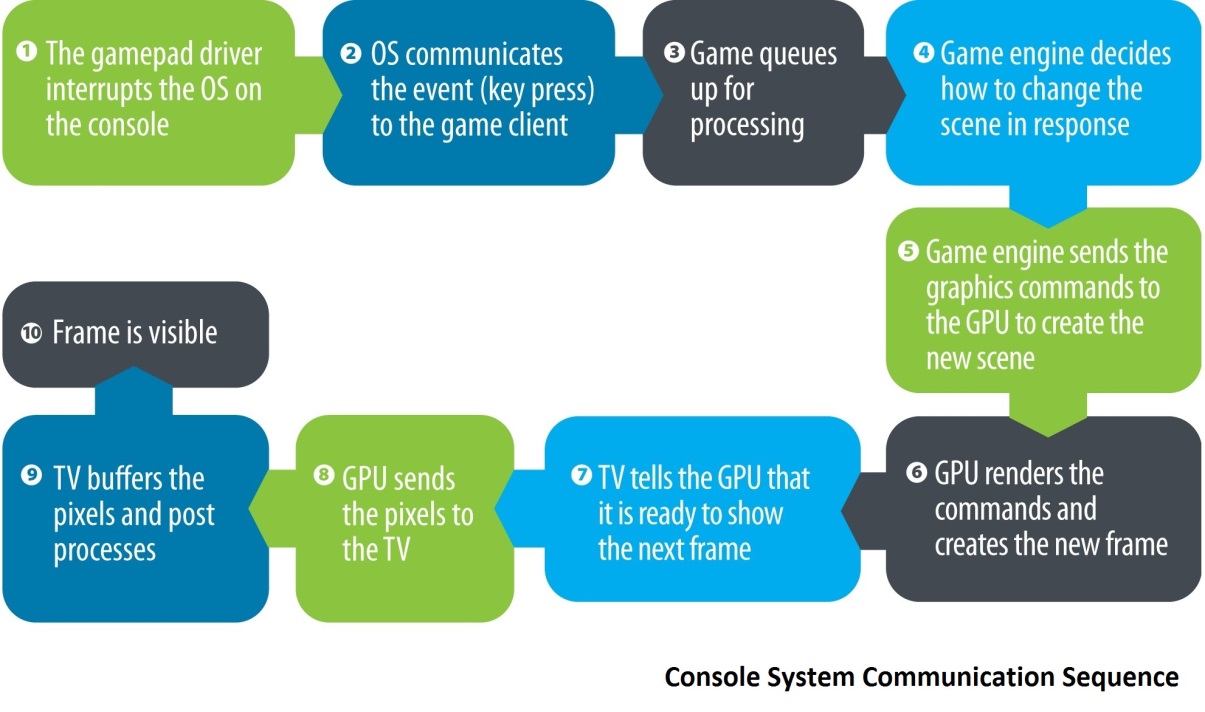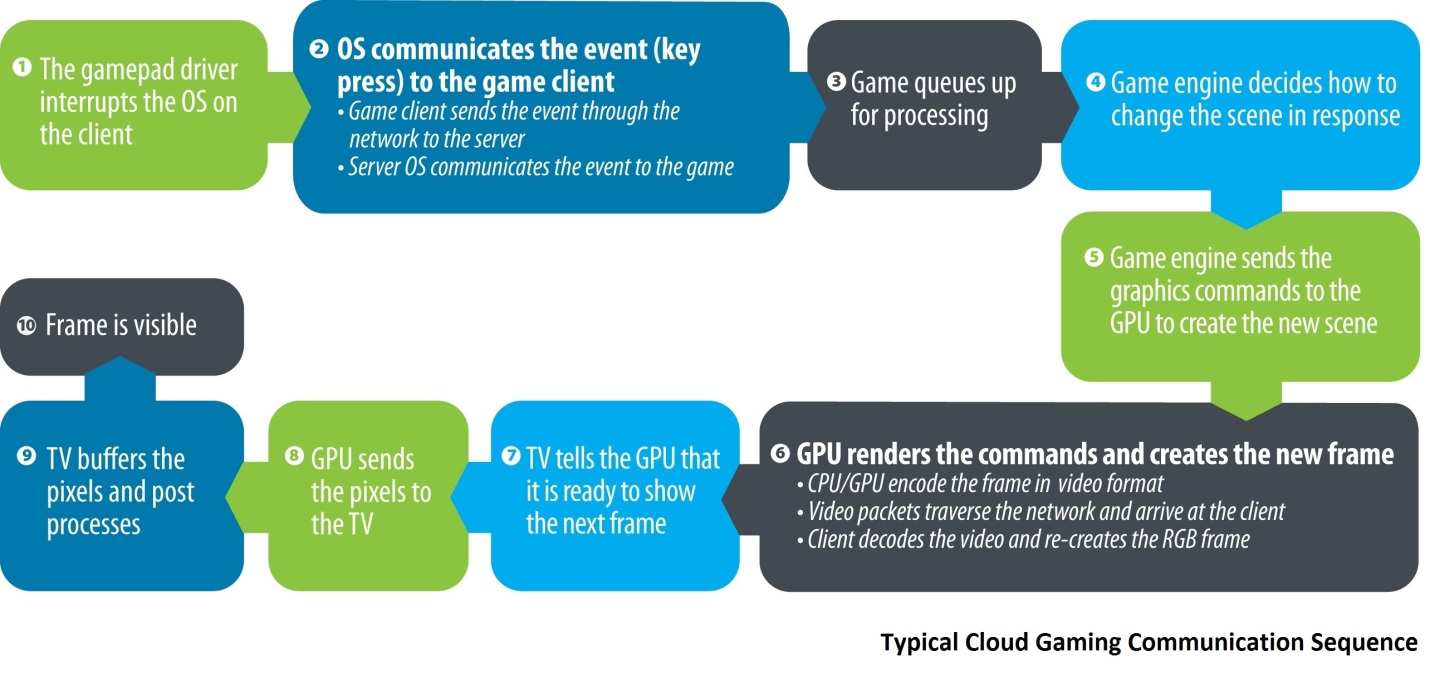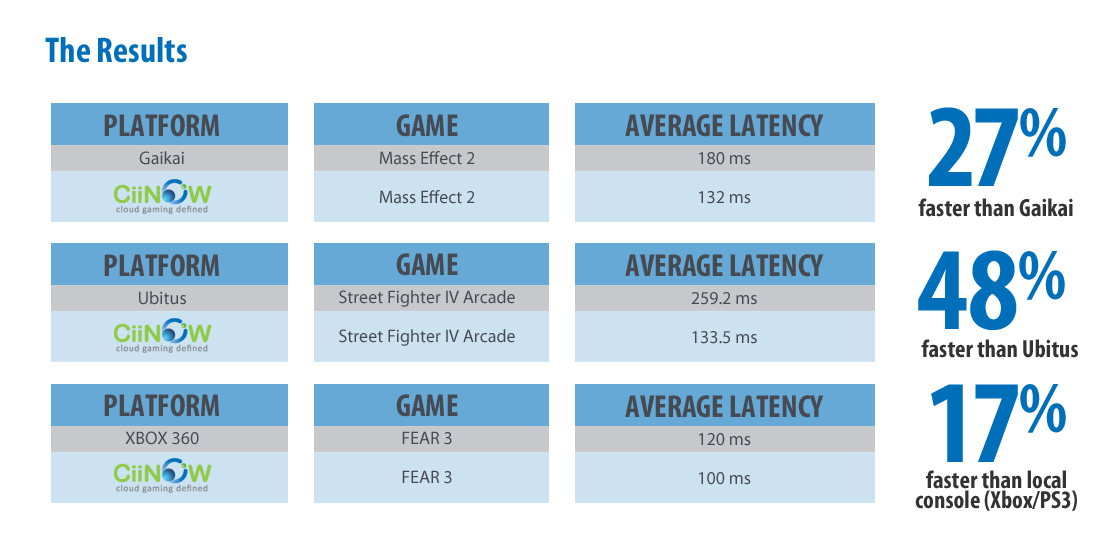By Makarand Dharmapurikar, CTO and Co-Founder, CiiNOW, Inc.
There has been much discussion of late, in both the media and technology circles, about latency and how it impacts the viability of Cloud Gaming as an option for gamers1. While definitions of latency abound, I want to delineate a common description of what we, as a Cloud Gaming technology company, are testing for, and then reveal some significant new research findings about latency.
Latency Defined
Latency, or lag in this context, is a measure of the time delay experienced by a system. In gaming terms, it is the time between the user input and the picture change that is a result of this input. Latency is important because it can significantly affect the quality of the gaming experience, and consequently a user’s interest in ever playing that game again on a particular device—a chief concern for any game developer, game publisher, or service platform provider.
Gamepad Play via Console
Below are the typical steps involved in a console system communication sequence once a gamepad key is pressed:
 It is important to note that everything after the GPU rendering (step 6) happens on a frame boundary, which equates to approximately 16.6 milliseconds at 60 fps. On a dedicated console with a highly optimized game, steps 3-6 can take anywhere from 50-80 milliseconds, and steps 7-10 take another 30-60 milliseconds, depending upon the TV. This yields a total end-to-end latency of between 100 and 150 ms on the current generation consoles, which is just fast enough to make games feel smooth for the majority of gamers, yet certainly nowhere near their potential. A high-end gaming PC can easily reduce this latency by several frames.
It is important to note that everything after the GPU rendering (step 6) happens on a frame boundary, which equates to approximately 16.6 milliseconds at 60 fps. On a dedicated console with a highly optimized game, steps 3-6 can take anywhere from 50-80 milliseconds, and steps 7-10 take another 30-60 milliseconds, depending upon the TV. This yields a total end-to-end latency of between 100 and 150 ms on the current generation consoles, which is just fast enough to make games feel smooth for the majority of gamers, yet certainly nowhere near their potential. A high-end gaming PC can easily reduce this latency by several frames.
The Key to Cloud Gaming Latency
In the world of Cloud Gaming, the concept of frame time is critical. Game engines process the input events in terms of number of frames. If a game is running at 2x the frame rate, the absolute time needed to process the event drops by half—which is the key to Cloud Gaming latency. A typical Cloud Gaming server is far more powerful than a typical console, and playing games via a cloud-based platform will drop the game event processing time by 2x to 3x that of a console experience.
Let’s dive deeper. In the games-via-cloud scenario, the following steps occur…
 The typical Cloud Gaming communication sequence is similar to the console system communication sequence cycle as shown above, however there are some very important differences. In the above diagram, steps 2 and 6 are expanded to include video processing and network transport. In a well architected system, the video processing and network transport will run in parallel, so video packets get delivered over the network as soon as they are ready.
The typical Cloud Gaming communication sequence is similar to the console system communication sequence cycle as shown above, however there are some very important differences. In the above diagram, steps 2 and 6 are expanded to include video processing and network transport. In a well architected system, the video processing and network transport will run in parallel, so video packets get delivered over the network as soon as they are ready.
When thinking about latency for Cloud Gaming, we need to consider the impact of speed of light through fiber, which is approximately 5 milliseconds for every 1000 km. Each router hop contributes a few milliseconds of buffering to the network. A modern broadband network (Verizon, Comcast, etc.) will provide a 15-20 millisecond ping time, or 8-10 milliseconds each way, to a data center in most metro areas. Cumulatively, the delay added to a Cloud Gaming system can be capped at 20 milliseconds with a handful of data centers covering the entire country. With the addition of the required video encode/decode, a Cloud Gaming platform delay increases to approximately 40 milliseconds more than what can happen on a console. Once a powerful server is introduced into the mix, console performance is decimated significantly. In sum, by running at a higher frame rate and on a vastly powerful CPU/GPU, we recover the 40 milliseconds, and then some—and the net result is stunning.
The Proof / Replicating the Findings
At CiiNOW, we have proven beyond any doubt that this reduced latency is not just theory but that end-to-end latency during cloud-based gameplay is comparable to what is experienced on current generation consoles. In fact, our research findings reveal that games can be played on demand from any device via the cloud often with less latency than playing a console game at home.
As our VP of Marketing and Publisher Relations, Chris Donahue, recently reported in a published article on VentureBeat (http://venturebeat.com/2012/12/17/is-cloud-gaming-viable-myth-vs-reality), we have discovered the following…
1. CiiNOW’s technology is faster, and with lower latency, than all other cloud gaming platforms.
2. CiiNOW’s technology enables a compelling and immersive gaming experience which is comparable to playing on a console.
When it comes to a Cloud Gaming latency discussion, it helps to nail down the exact methodology. The goal is to allow you, the reader, to recreate the measurements yourself and become a believer. To achieve this, we chose to go with simplicity without sacrificing accuracy. You will need a high speed camera such as a Panasonic FZ 200 or the Casio Exilim line of cameras which can shoot at 240 fps or higher. You will also need a visual cue which can act as a start trigger to measure the start of the action.
Same PC, TV, Cable, Network, Game, Game Scene
The first order of business is to identify a game that’s available on our service and suited to measure latency. The game needs to allow re-mapping of the CAPS LOCK or NUM LOCK key, any key which lights an LED on the keyboard—Mass Effect 2 and F.E.A.R. 3 are some game titles that work well in this regard. The next step is to identify a specific scene in the game which could change in a visible way with an action that can be mapped to that key (e.g. shooting a gun or bringing up the OSD menu).
After both game and scene selections are complete, we must then characterize the network by measuring the ping time. For our purposes, this was done easily by running a continuous ping test to the CiiNOW server and recording the results. A quick inspection of ping results should show a steady range of ping times, preferably in the 10-20 millisecond range. Note: It is important to keep the ping test running while the game is in progress.
Roll the Camera
Now the funs begins—set the camera for high speed (240 fps) recording mode and position the camera such that it captures both the keyboard LED and relevant portion of the scene. Continue to play the game to the point where the game scene of interest occurs, and press CAPS LOCK. Both the screen LED change state and the screen change should be visible. Repeat this multiple times (10 minimum) to eliminate any network glitches or errors.
Analyzing the Results
After the measurements are captured, it is time to analyze them. We chose to open the video recording using Apple Quicktime, which allows frame-by-frame advance of the video, and helps in accurately measuring number of frames between two events.
Locate the first event (LED change state) and second event (screen change) and count the number of frames in between those events. Each frame is roughly 4.16 milliseconds (1/240 seconds). Multiply the number of frames by 4.16 and that becomes the true, end-to-end latency. To account for variation in parameters, we recommend taking several (10 or more) measurements at a time and averaging them.
We put this methodology to test with CiiNOW servers located in public data centers and produced the following results:

Conclusions…and Beginnings
As one can see, the numbers tell a very different story from what conventional wisdom says about Cloud Gaming—not only is the latency more than acceptable, it is less than what exists in the current generation consoles. It is also notable that the findings were uniform across game genre, games used were as varied as LEGO Harry Potter, Far Cry 2, and Game of Thrones, and all fall into this bucket of sub-100 ms latency. Using these numbers, the economics of supporting an efficient cloud-based technology platform for delivering console-class game content makes sense. Even one frame time of latency advantage means that data centers hosting a Cloud Gaming service can be located within a 1000 mile radius to the end user and still maintain console quality latency. Today, the proliferation of a seamless Cloud Gaming delivery mechanism varies by geographical region, and a well-designed network with appropriate QoS provisioning at every step is required for it to scale. Fortunately, service providers and service operators worldwide are realizing the potential and financial opportunity of offering their customers a branded channel of streamed game content. By partnering with cloud-based platform innovation such as what CiiNOW has architected, we are confident in their ability to deliver…and soon!
We invite you to experience the power of our research findings first-hand. If you require additional information about our testing procedures, would like to sign up for a test account, or are interested in being a beta tester, please contact us at info@ciinow.com.
1Article reference:http://gigaom.com/2012/12/01/why-your-next-game-console-ought-to-be-watson/

